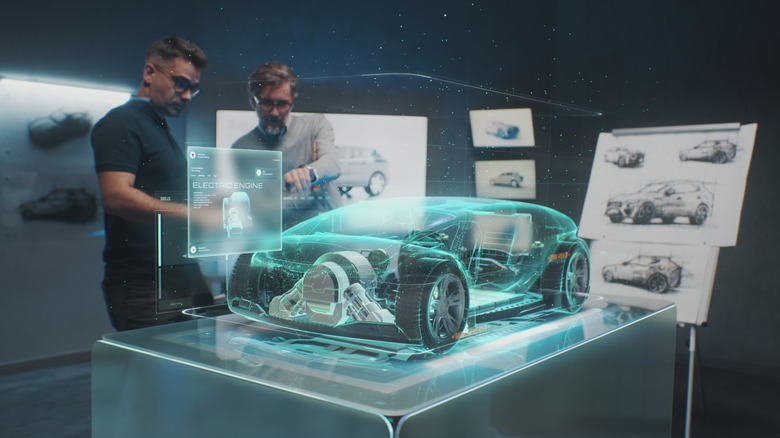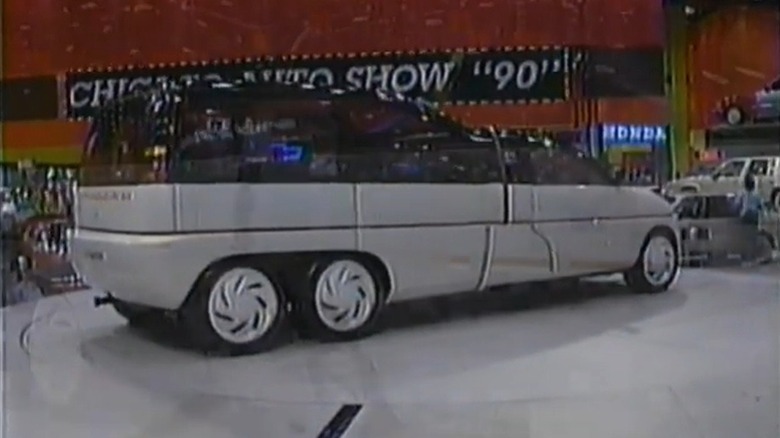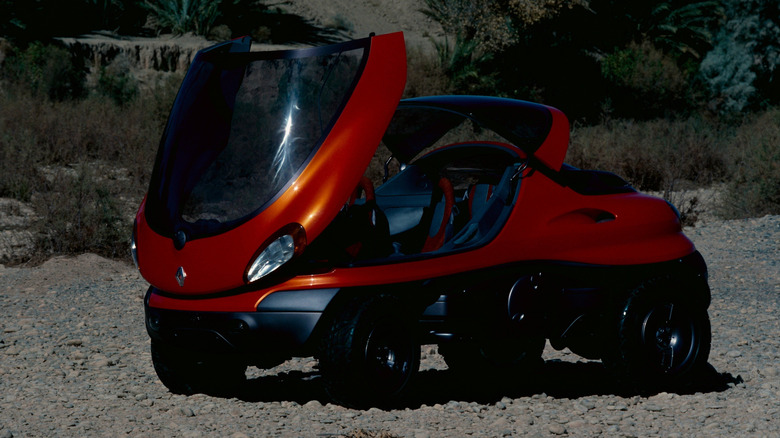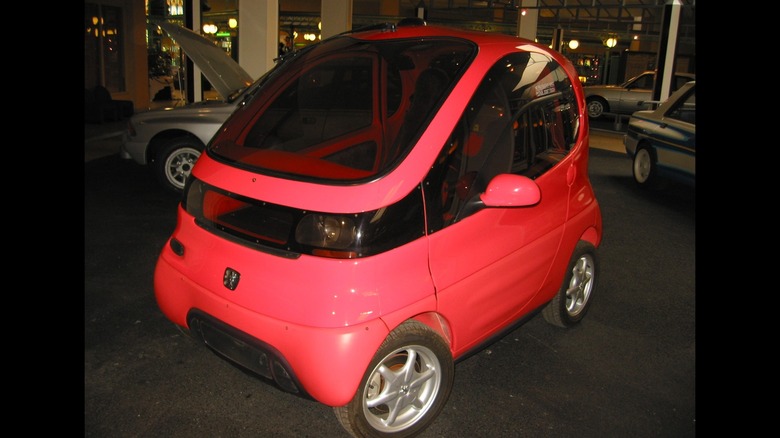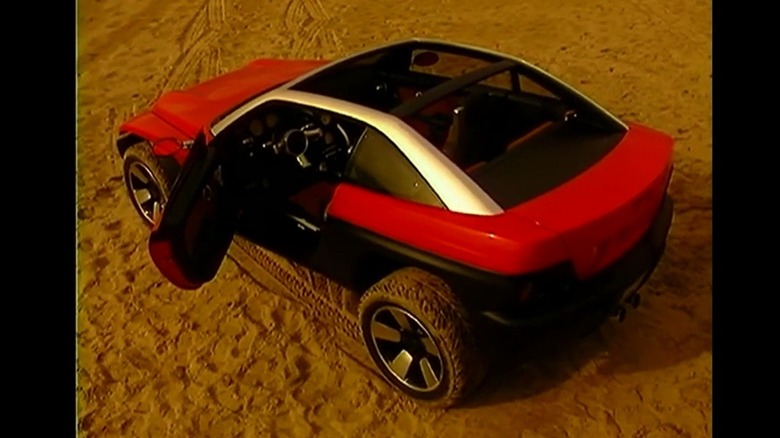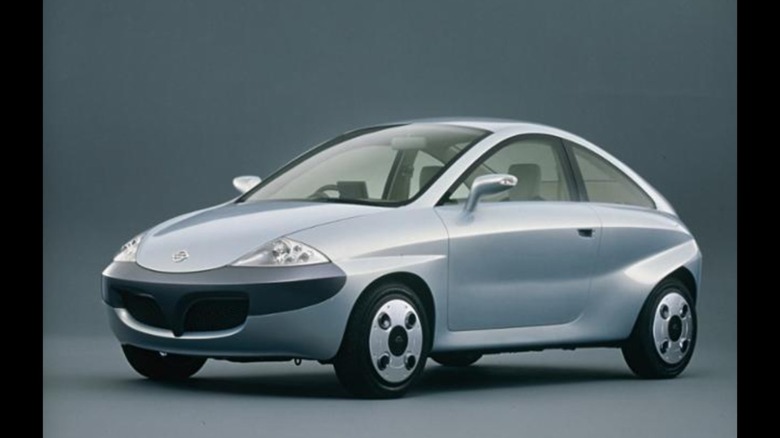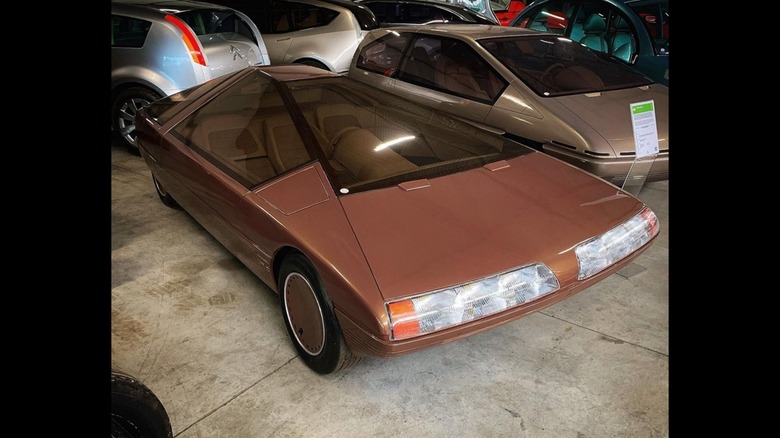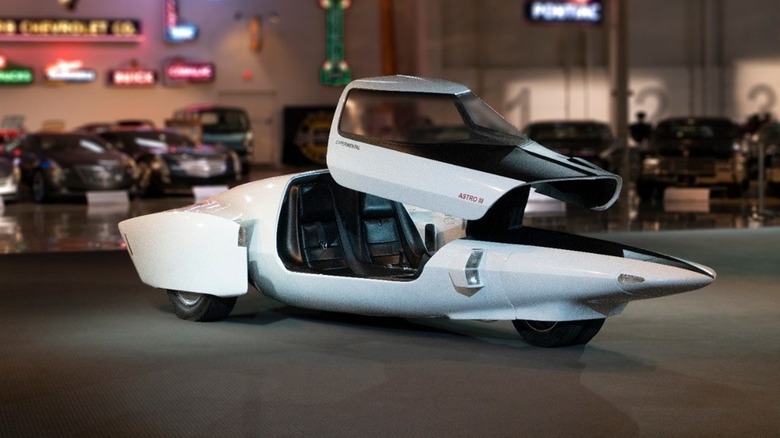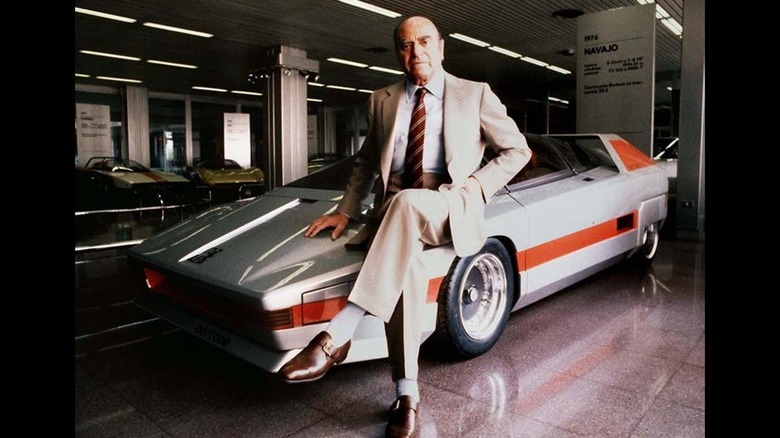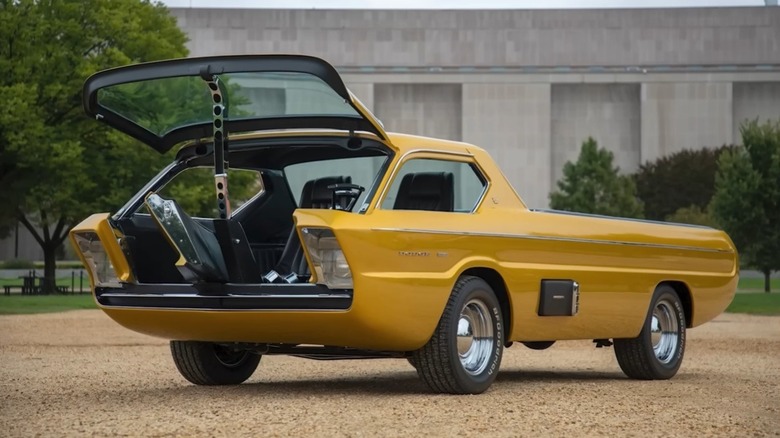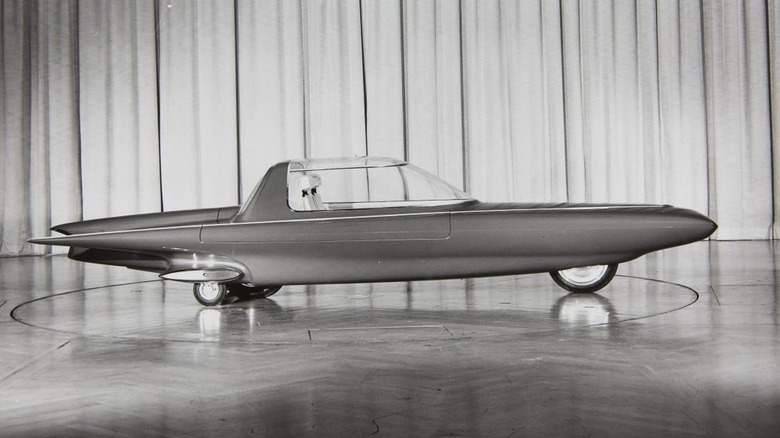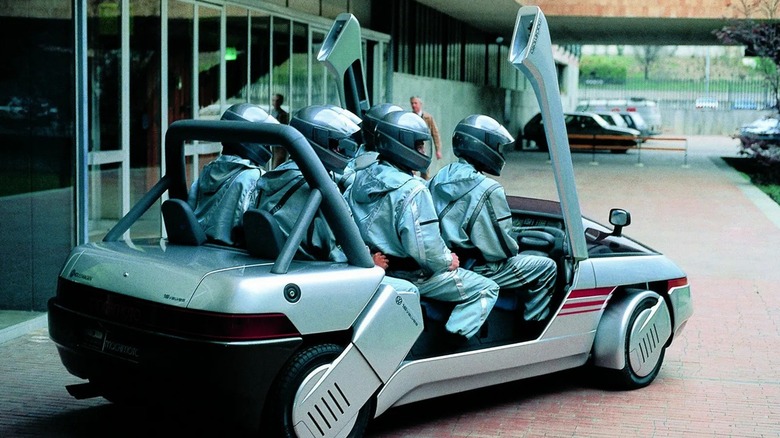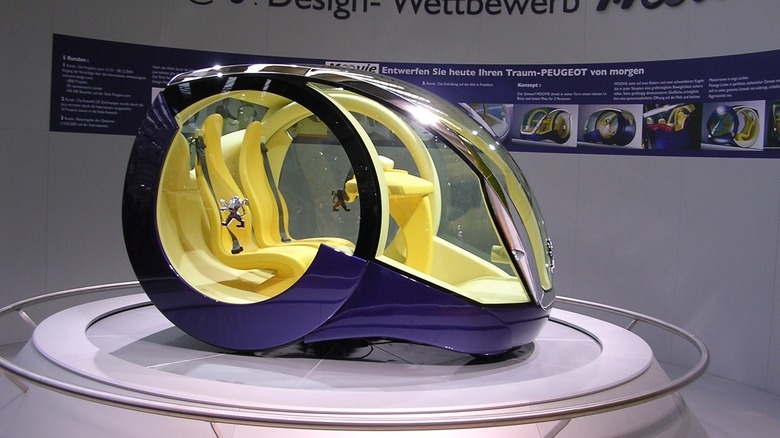12 Of The Weirdest Concept Cars We've Ever Seen
Concept cars are sometimes vehicles intended for release which never make it out of the development stage. More often, it refers to one-off vehicles produced by car manufacturers and displayed at car shows to highlight emerging technologies or design features and gauge consumer interest. Car shows are the automotive equivalent of New York Fashion Week, showcasing the extremes of the artform even if those products are never intended to hit the market.
While the entirety of a concept car may never make its way onto the roads, individual design elements or features often do trickle down into the market. In fact, some of the features which are widely available in consumer vehicles today, like GPS systems and rearview cameras, made their first appearances in the concept cars of yesteryear. Moreover, while the more extreme designs typical of concept cars rarely hit the mainstream, subtler iterations often come into vogue years down the line.
In the past, SlashGear has covered the coolest concept cars ever made and the concept cars which were way ahead of their time. Now, check out some of the weirdest concept cars to ever roll into an automotive show room.
Plymouth Voyager III
The Plymouth Voyager III is objectively one of the weirdest and most imaginative concept cars ever made. It was constructed in 1989 and premiered at the 1990 Detroit Auto Show, offering a new way to think about how cars could work.
In point of fact, the Voyager III may have been one of the worst concept cars ever made. It combined two vehicles in one wacky package. In its full configuration, the Voyager III could carry eight passengers with three in the front and five in the back. If you didn't need that much cargo or passenger space, the front section disconnected, transforming into a three-passenger mini-car. Each section had its own dedicated engine, allowing you to use the Voyager III as a commuter car in the city or like a camper for longer journeys.
Designers imagined the Plymouth III as a modular vehicle, allowing consumers to choose between an array of possible attachments including the standard five passenger van attachment, a flatbed trailer, a boat trailer, and more. When connected, the rear of the microcar folded down and sat flush with the van floor, turning the two components into one seamless vehicle. The mini-car also featured a rear camera and an overhead viewscreen to help the driver with docking. One notable downside was that the van attachment remained open at the front when not in use, so you'd need to store it in a garage.
Renault Racoon
Rather than the small urban mammal it's named after, the Renault Racoon more closely resembled a beetle merged with a space age rover. It was designed to be amphibious, transitioning easily from land to water, and was capable of raising and lowering the body for greater obstacle clearance, courtesy of an electro-hydraulic suspension system.
Four chunky wheels supported a rounded passenger compartment dominated by a massive windshield which reached out and around, arching overhead into an oversized sunroof. Lifting up that huge window and crawling through was the only way to get in or out. While the design was unconventional, it offered a range of cool features which would have made it a delight to drive.
Each axle could be adjusted independently, so that the passenger compartment remained level even on uneven terrain. It also tested technologies which are relatively commonplace today, like satellite navigation and external cameras, but which were cutting edge at when the Racoon debuted in Geneva, Switzerland in 1993. The Racoon could carry three passengers in total, two in the front with a third in a mid-mounted rear seat. And it could carry those passengers at speeds up to 96 miles per hour on land and 5 knots in the water.
Peugeot Tulip
A co-venture of Peugeot and Citroën, the Tulip reimagined not just how a car could look and function, but also how it could be used by the public. It was an attempt at a functional electric vehicle (EV) way back in the mid-'90s and intended to be owned by no one in particular.
The Tulip was a slow-moving vehicle with a top speed of just 43 miles per hour, a maximum range of about 50 miles, and space for only two passengers, but that might have been okay for its intended use. The Tulip was designed not as a personal vehicle but as a sort of rideshare transportation. In fact, its name was an acronym standing for Transport Urbain Libre Individual et Public ("Free Individual and Public Urban Transport"). The idea was that you'd sign up for the service and call a car when you need one or pick one up from a local depot, then return it when you're finished.
Users would have had a personal remote, similar in design to a pocket calculator or an old telephone, which allowed users to access cars and contact customer support. All of which was objectively cool, especially for the '90s, but the Tulip did look like a party balloon that had been left to deflate for a couple of weeks.
Jeep Jeepster
Before the Jeep Jeepster debuted at the 1998 North American International Auto Show (NAIAS), it was a secret endeavor codenamed Project Grizzly. From the beginning, the Jeepster was an experimental car, intended to cover your driving needs from grocery store parking lot to wilderness trails and all points between.
More than just expanded functionality, the Jeepster was an attempt to marry the power and flair of a sports car with the off-road capabilities of the Jeep Wrangler. The result was an oddly shaped vehicle which conjures visions of a clamshell takeout container with wheels.
For normal driving, the Jeepster sat just 5.75 inches from the ground, maintaining a low profile for better on-road stability. When off-roading, the height could be increased to 9.75 inches using a pair of switches mounted in the interior, making it easier to crawl over boulders. The whole thing was powered by the same 4.7-liter 16-valve V-8 engine found in the 1999 Jeep Grand Cherokee. The wheels featured Goodyear's Extended Mobility Tires (EMT) which could keep their shape for 50 miles at speeds up to 55 miles per hour after getting a flat.
Nissan Cypact
At the turn of the century, Nissan designed a weird little concept car called the Cypact in hopes of addressing the looming threats of air pollution and anthropogenic climate change. The Cypact was powered by the NEO Di direct-injection turbo diesel engine, which brought down the car's weight, improving fuel efficiency, and reducing the vehicle's emissions. Everything about it was designed to minimize fuel costs and the car's impact on the environment.
The Cypact debuted in 1999 at the 58th Frankfurt Motor Show, promising an updated class of fuel efficient vehicles for the new millennium. The Cypact could travel 100 kilometers, or about 62 miles, on 3 liters of fuel. That works out to a fuel economy of about 78 miles per gallon, considerably better than even the average commuter car more than 25 years later.
The only real downside to the Cypact is its unusual exterior which immediately makes you feel like you're driving your car through Uncanny Valley. The car of the future had to look novel and a little unfamiliar. The Cypact succeeds on those fronts but it just doesn't look cool. Still, at over 75 miles per gallon you might be able to forgive its unconventional looks.
Citroën Karin
Citroën didn't have anything to exhibit for the 1980 Paris Salon, so the company tasked designer Trevor Fiore with creating a concept car in time for the show. Fiore had recently taken over as director of Citroën's design studio, and this was the first concept to come out of his tenure. Fiore delivered the Karin, a bizarre pyramid-shaped vehicle with some of the hardest angles you've ever seen.
The goal was to imagine a car of the future and, when seen from certain angles, the Karin succeeds wonderfully. When viewed from the front, however, the illusion is lost and you realize you're looking at something truly unusual. Fiore designed the trapezoidal Karin over the course of a week and a half and the model was built in 6 months, in time for the Paris Salon.
Its unique design forced an unconventional seating arrangement inside. The driver was centered at the front with room for a passenger on either side. Of course, what you see is what you get. The Karin on the show floor had no interior mechanics and was incapable of starting up and going anywhere. Then again, because it was never intended to hit production or even to move off the showroom floor, Fiore had more flexibility to play with the design, without consideration for actual functionality. And, in a world of increasing homogenization, there's something to be said for a designer stretching their legs.
Chevrolet Astro III
As the name suggests, the Astro III was the third and most ambitious of Chevy's Astro concept cars. Designed by Bill Mitchell alongside Corvette chief engineer Larry Shinoda, the Astro III was unveiled to the public in 1969 at the Chicago Auto Show. It was modeled after the body of a jet airplane, even the wheels were reminiscent of landing gear, with one wheel in the front and two in the back.
The Astro III incorporated elements of aviation under the hood, too. It was powered by an Allison 250-C18 gas turbine engine originally developed for military and civilian helicopters. Designers imagined the Astro III as a car of the future, built to navigate special highways intended for high performance vehicles, where people could zoom across the landscape like Speed Racer.
Access to the passenger compartment was gained through the windshield, which raised upward and outward like a jet cockpit. Without any exterior mirrors, the driver used a closed circuit television system to see behind them. It was a truly space age car which debuted the same year Neil Armstrong and Buzz Aldrin put the first boot prints on the Moon.
Alfa Romeo Navajo Bertone
Alfa Romeo's 33 Stradale is a curvaceous late-'60s sports car which provided the foundation for a wide array of concept cars. A total of six experimental automotive designs were built on the Stradale's chassis.
The Carabo was named for the Carabus beetle, and featured an insect-like design with a sloped hood and green exterior with yellow accents. The Iguana was designed by Giorgetto Giugiaro, of Delorean fame, and was finished in a similar metal-flake gray and brushed metal. The Cuneo was sleek, white, and wedge shaped, with a yellow stripe down the middle. The Speciale was a two-door coupe designed by Leonardo Fioravanti featuring a sleek yellow design reminiscent of a predatory wasp. And the Roadster was a two-seater convertible with a low-profile windshield, pointed front end, and a mid-body spoiler positioned just behind the seats and above the rear-mounted engine. But the Navajo was easily the most memorable.
Unveiled at the 1976 Geneva Motor Show, the Alfa Romeo Navajo Bertone traded the curves of the Stradale for the hard angles of science fiction. With a gray fiberglass body and orange accents, it looked like a mix between a Rebel Alliance spaceship and an NES Zapper. Today, it exists in the Alfa Romeo museum collection.
Dodge Deora
The Dodge Deora is part concept car, part custom build, and as bizarre as it is cool. The effort began when brothers Mike and Larry Alexander, well-known in the custom car community, decided they wanted to play with the newly popular cab-over (where the cab is positioned over the engine instead of behind it) pickup trucks. The Alexander brothers enlisted the help of former GM designer Harry Bentley Bradley, who they had worked with on previous custom jobs.
Bradley turned in a design which minimized cutlines dramatically by removing the doors entirely, and Chrysler liked it enough that the company gifted the trio one of its A100 trucks to do with what they wished. After they chopped it up and sewed it back together, using parts from other consumer vehicles, the resulting vehicle had a much lower profile and no visible entry point.
The Deora so completely reimagined its source material that, at first glance, it's difficult even to know which way the vehicle is facing. Getting in relied on a complex two-part door system. The top half of the front end, including the windshield, lifted upward while the bottom half swung sideways horizontally from the center. While only one functional Deora was ever constructed, it became such a popular show car that AMC made model kits and Hot Wheels included it in the Sweet Sixteen, its original set of scale model cars.
Ford Gyron
The Ford Gyron looks like something ripped straight from an episode of "The Jetsons" and perfectly embodies the sort of retro-future aesthetic the '60s was famous for. It features only two wheels, running down the center of its streamlined body like a motorcycle.
It would have used a gyroscope (hence the name) to keep itself steady while in motion, but that functionality wasn't completed in time for the show. Instead, it was held up by a pair of smaller support wheels which acted like kickstands and ostensibly would have retracted at higher speeds, handing over balance to the gyroscope system. Lacking any conventional doors, passengers would have gotten in and out of the Gyro through the top hatch, which levered up from behind exposing a pair of passenger seats.
Ultimately, the Gyro ended up at the Ford Rotunda, which was originally built for the 1933 – 1934 Chicago World's Fair. Sadly, on November 9, 1962, a fire started while the Rotunda roof was being repaired. The fire destroyed the building, injured one person, and destroyed automotive artifacts including Ford's Gyro concept car.
ItalDesign Machimoto
The Machimoto from ItalDesign defies definition and convention by combining the stability of a four-wheeled passenger vehicle with the wind in your hair experience of a motorcycle. Although, some might argue you can get essentially the same thing from a golf cart.
Unveiled at the 1986 Turin Motor Show, the Machimoto was intended to be an adventuring car for young people, carrying up to nine people at a time. In its standard configuration it carried six people comfortably, but could be upgraded to nine with an additional row of seating. It was built on the foundation of the Volkswagen Golf GTI with an admittedly futuristic redesign.
It was the brain child of famous automotive designer Giorgetto Giugiaro, best known for designing everyone's favorite time machine, the DMC Delorean. Still, rather than the hip transportation of a new generation, the Machimoto looked almost like something you'd see Bond villains driving around a supervillain's secret underground lair.
Peugeot Moovie
Peugeot hosts the Peugeot Design Competition, a global contest which invites professional and amateur designers to submit their own designs for a potential concept car. It's the sort of thing that promotes truly novel ideas from emerging talents. In 2005, a young college design student named Andre Costa won the competition after delivering a futuristic travel pod which came to be known as the Peugeot Moovie.
It's a futuristic vehicle with wheels almost perfectly hidden behind and beneath its expansive rounded frame. The vehicle's exterior was crafted from a minimal metal frame filled in with huge windows, making the Moovie look more like a fast bubble than a conventional car. For entry and exit, massive side doors slid out, allowing access to a pair of interior seats.
It's the sort of car you'd expect to find in a science fiction flick based on an Isaac Asimov novel or rolling over the prehistoric plains of "Jurassic World." Just don't expect to see one cruising down the highway anytime soon.
